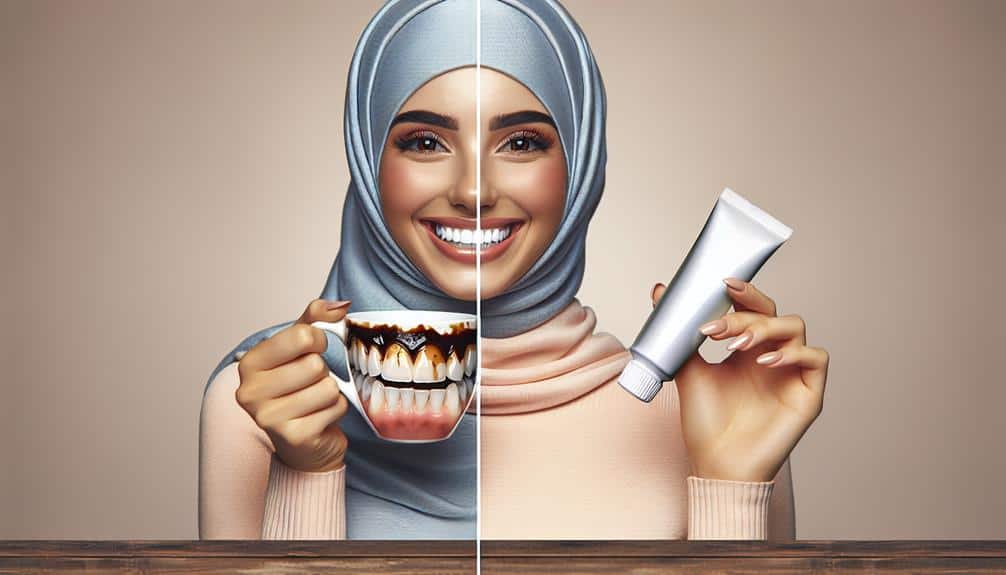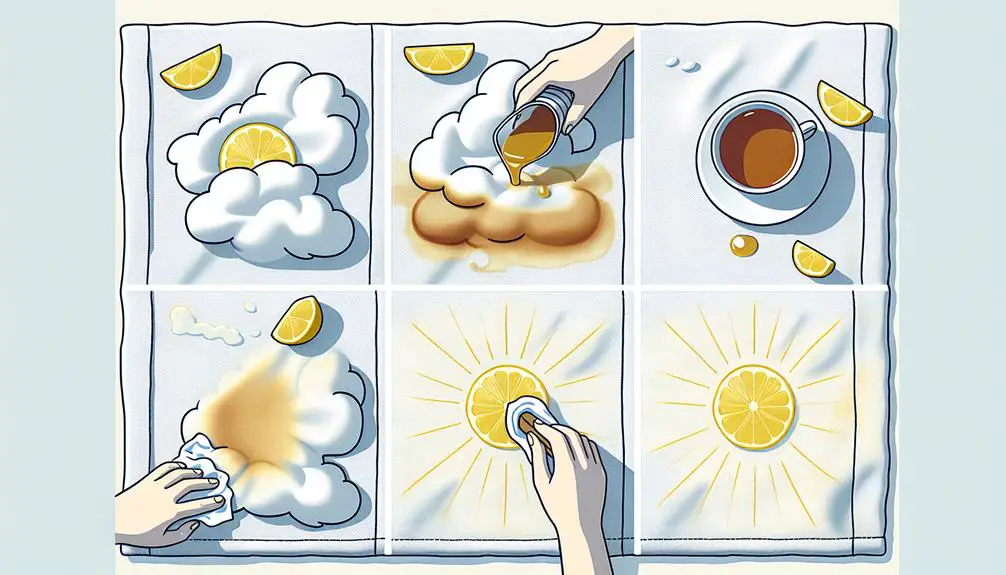To prevent tea stains and whiten teeth: brush with fluoride toothpaste after tea, opt for whitening toothpaste, rinse your mouth with water post-tea, limit tea intake, use enamel-friendly straws, try oil pulling, and see your dentist regularly. Keep your smile bright and healthy by following these 7 tips. Your teeth will thank you for it!
Key Points
- Brush teeth with fluoride toothpaste post-tea consumption.
- Use whitening toothpaste to remove and prevent stains.
- Drink tea through a straw to minimize teeth contact.
- Practice oil pulling for natural teeth whitening benefits.
- Regular dental visits for professional cleanings and advice.
Brush After Tea Consumption
To prevent tea stains and maintain a bright smile, make sure to brush your teeth after consuming tea. Tea contains tannins that can lead to discoloration of the teeth over time. By brushing immediately after drinking tea, you can prevent these stains from setting in and maintain good oral hygiene. Use a fluoride toothpaste and a soft-bristled toothbrush to gently scrub away any residue left by the tea. Pay special attention to brushing along the gumline and the back molars where stains tend to accumulate.
Incorporating this simple step into your oral care routine can make a significant difference in preventing tea stains and keeping your smile looking its best. Remember to brush for at least two minutes, reaching all surfaces of your teeth. Additionally, consider using a whitening toothpaste or mouthwash to help combat any existing stains and brighten your smile. Consistent and thorough oral hygiene practices won't only prevent tea stains but also contribute to overall dental health.
Drink Through a Straw
Consider using a straw when drinking tea to minimize direct contact between the tea and your teeth, reducing the risk of stains. Straws can serve as effective straw alternatives for those with teeth sensitivity, as they help in bypassing direct exposure to the tea's staining components.
When choosing a straw, opt for designs that offer enamel protection, such as silicone or stainless steel options. These materials are gentle on teeth and can prevent potential damage to the enamel.
By sipping tea through a straw, you create a barrier between the liquid and your teeth, diminishing the likelihood of stains while still enjoying your favorite brew. Remember, the goal is to maintain your smile's brightness while indulging in tea, and using a straw is a simple yet effective way to achieve this.
Incorporating a straw into your tea-drinking routine shows a proactive approach to preserving your teeth's whiteness, making it a worthwhile habit to adopt.
Rinse With Water After Tea
Rinsing your mouth with water after consuming tea can help avoid stains on your teeth and maintain their whiteness. Tea stains are well-known for sticking to enamel, but a simple rinsing technique can make a significant difference in preserving the brightness of your smile. By swishing water around your mouth immediately after drinking tea, you can rinse away the pigments that may lead to discoloration.
The key to this method is to be consistent and thorough. Make sure that you cover all areas of your mouth where the tea may have come in contact with your teeth. This quick and easy habit can be especially effective when you're unable to brush your teeth right after consuming tea.
In addition to preventing stains, rinsing with water can also help in reducing the acidity levels in your mouth, which can have a positive impact on your overall oral health. Make it a habit to rinse with water after your tea to keep your smile bright and free from tea stains.
Use Whitening Toothpaste
If you're looking to brighten your smile, consider switching to a whitening toothpaste.
These toothpastes offer benefits beyond just cleaning your teeth, as they're specifically formulated to help whiten and remove stains.
When used consistently, whitening toothpaste can be effective in enhancing the brightness of your teeth.
Toothpaste for Whitening
To guarantee a brighter smile, incorporate the use of whitening toothpaste into your daily oral care routine. Whitening toothpaste is formulated to help remove surface stains on teeth, resulting in a whiter appearance.
Unlike natural alternatives or DIY remedies, whitening toothpaste often contains special abrasives or chemicals that are more effective at polishing and brightening teeth. When selecting a whitening toothpaste, look for one that carries the American Dental Association (ADA) seal of approval to confirm its safety and effectiveness.
Keep in mind that while whitening toothpaste can help maintain the whiteness of your teeth, it may not be as effective as professional whitening treatments for significant discoloration. Consistent use of whitening toothpaste, alongside regular dental check-ups, can contribute to a healthier, brighter smile.
Benefits of Whitening
Incorporate the use of whitening toothpaste into your daily oral care routine to enjoy the benefits of a brighter, more radiant smile. Whitening toothpaste offers various advantages beyond just aesthetics.
Not only can it help remove surface stains caused by tea and other pigmented foods, but it also contributes to overall oral health. These toothpastes often contain ingredients that aid in plaque removal and fight against cavities, promoting healthier gums and teeth.
Whitening Toothpaste Effectiveness
To enhance the effectiveness of whitening toothpaste, contemplate incorporating it into your daily oral care routine for a brighter, more radiant smile. Whitening toothpaste contains abrasive particles and chemicals that aid in removing surface stains on teeth.
When used consistently, it can gradually lighten stains caused by tea, coffee, or other factors. However, for more stubborn stains, you may want to contemplate additional treatments like whitening strips or home remedies. Some natural options include using baking soda or charcoal powder, which can help whiten teeth over time.
Try Oil Pulling
Looking to naturally enhance your oral health?
Oil pulling might be the solution you're seeking.
Discover the benefits of this ancient practice, learn the proper technique, and find out how often you should incorporate oil pulling into your routine.
Get ready to experience the potential advantages of oil pulling for your teeth and overall dental hygiene.
Benefits of Oil Pulling
Consider trying oil pulling as a natural method to improve oral health and whiten teeth. Oil pulling involves swishing oil around in your mouth to remove bacteria and promote overall oral hygiene.
Here are three key benefits of incorporating oil pulling into your oral care routine:
- Natural Teeth Whitening: Oil pulling can help reduce stains on your teeth, leading to a brighter smile without the use of harsh chemicals.
- Improved Oral Health: By swishing oil in your mouth, you can help remove harmful bacteria, reduce plaque buildup, and improve gum health.
- Fresh Breath: Oil pulling can help eliminate bad breath by removing odor-causing bacteria from your mouth, leaving you with a fresh and clean feeling.
How to Oil Pull
To properly execute oil pulling and reap its benefits, start by selecting a high-quality oil such as coconut or sesame oil for swishing in your mouth.
Oil pulling is a traditional practice known for its oral health benefits. To begin, take a tablespoon of your chosen oil and swish it around your mouth for about 15-20 minutes, making sure not to swallow any of it. This technique helps remove harmful bacteria, reduce plaque buildup, and freshen your breath.
After swishing, spit out the oil into the trash as it can clog drains. Oil pulling has shown promising results in improving oral hygiene, but be cautious of potential risks like stomach upset if oil is accidentally swallowed.
Oil Pulling Frequency
For best oral health benefits, include oil pulling into your routine at least three times a week to effectively maintain a healthy mouth. Oil pulling, an ancient Ayurvedic practice, offers numerous benefits for your oral hygiene.
- Oil Pulling Benefits:
- Reduces harmful bacteria in the mouth.
- Helps prevent plaque buildup.
- Promotes fresher breath by eliminating toxins.
- Oil Pulling Techniques:
- Use a tablespoon of coconut or sesame oil.
- Swish the oil around your mouth for 15-20 minutes.
- Spit out the oil into a trash can to avoid clogging your sink.
Limit Tea Intake
To reduce the risk of tea stains on your teeth, moderate your consumption of tea to maintain a brighter smile. While tea is a popular beverage enjoyed for its taste and health benefits, excessive consumption can lead to stains on your teeth.
If you're a tea lover but concerned about the potential impact on your smile, consider exploring tea alternatives such as herbal teas or green teas, which are less likely to cause staining. Additionally, incorporating stain removal practices into your oral hygiene routine can help combat the effects of tea on your teeth.
Regularly brushing your teeth with a whitening toothpaste, using baking soda occasionally to gently scrub away stains, and rinsing your mouth with water after drinking tea can all aid in preventing and minimizing tea stains. By being mindful of your tea intake and implementing stain removal strategies, you can enjoy your favorite beverage while maintaining a radiant smile.
Visit the Dentist Regularly
Regular dental check-ups are vital for maintaining oral health and preventing tea stains on your teeth. Visiting your dentist regularly can help you address any potential issues early on and keep your smile bright and healthy. Here are three key reasons why dental check-ups are essential for oral hygiene:
- Professional Cleaning: Dental cleanings remove plaque and tartar buildup that can contribute to tea stains on your teeth. These cleanings can help prevent discoloration and keep your teeth looking their best.
- Early Detection: Regular dental check-ups allow your dentist to identify any signs of tea stains or other oral health issues early. By catching problems sooner rather than later, you can prevent further staining and maintain a radiant smile.
- Personalized Advice: Dentists can provide personalized advice on how to prevent tea stains based on your specific oral health needs. They can recommend the best oral hygiene practices and products to help you maintain a white and healthy smile between visits.
Frequently Asked Questions
Can Using Whitening Toothpaste Alone Effectively Remove Tea Stains From Teeth?
Using whitening toothpaste alone may not effectively remove tea stains from your teeth. Consider incorporating whitening strips for better results. Baking soda, known for its whitening benefits, can complement these efforts in achieving a brighter smile.
How Often Should Oil Pulling Be Done to See Results in Teeth Whitening?
How often should you do oil pulling for results in teeth whitening? Consistent oil pulling, ideally daily or at least a few times a week, can effectively help whiten teeth. Make it a habit for noticeable improvements.
Are There Any Specific Types of Straws That Are More Effective in Preventing Tea Stains on Teeth?
For preventing tea stains on your teeth, silicone straws are known for their effectiveness. On the other hand, bamboo straws are prized for their durability. Choosing the right type of straw can make a significant difference in maintaining your bright smile.
Is There a Recommended Time Frame for Rinsing With Water After Consuming Tea to Prevent Stains?
After consuming tea, rinsing with water promptly helps prevent stains. Consider herbal teas as alternatives to traditional black tea for lower staining potential. Keep up good rinsing techniques to maintain a brighter smile.
How Often Should One Visit the Dentist for Professional Teeth Whitening Treatments in Conjunction With At-Home Remedies?
When it comes to maintaining bright teeth, remember that professional dental checkups are crucial. Combining these with at-home whitening treatments can enhance your smile's radiance. Aim to visit your dentist regularly for the best outcomes.



